 By Pepper Parr
By Pepper Parr
February 28th, 2024
BURLINGTON, ON
Part 3 of a three part series on engagement about Robert Bateman Community Centre
Denise Beard, Senior Manager of Community Development at Parks, Recreation and Culture spoke to Council recently asking: “We would like to hear if there’s anything you do not want to see in this facility because our next steps are really to start to work with the community to prioritize those indoor uses.”
Beard was talking to Council about the meetings she had with people who were interested in using space at the Robert Bateman Community Centre (RBCC).
“The reason we’re doing this right now is because the design of phase two really needs to be determined now; it will be us working with the partners and the business owners in the not for profit sector on how they’d like to see the space used as we start negotiations. So it’s important for us to know this now so we can be ready for the official opening.
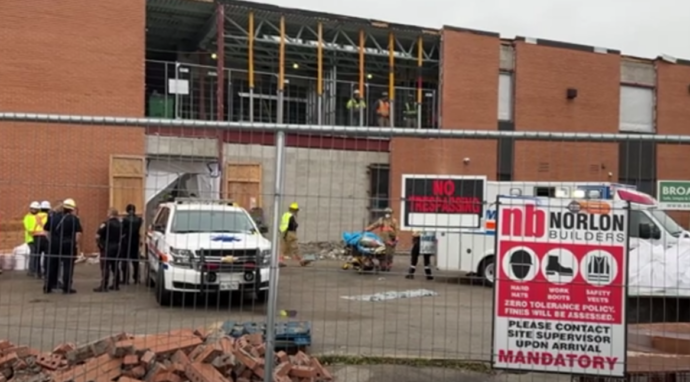
Robert Bateman Community Centre – a work in progress. Ambulances on site after an accident.
Beard said she needed to have those discussions now and prioritize now to help us design for phase two. We like the idea of trying to run a social anchor pilot at Tansley Woods. We are intrigued with the idea of watching what can happen and “eager to see how that takes off and in hopes that we meet community demand in the in the future at Bateman.”
Beard added: “We will be also be launching the engagement on outdoor uses of the site in the next quarter, to talk to community about their visioning of the outdoor spaces. What does that look like? Where do they have influence, where do they not have influence? We will be doing a few things this spring with the community prioritizing the indoor uses and then also talking about the visioning of the outdoor spaces all to help influence the next round of phase two design for (RBCC)
At that point Beard began to listen to what Council members thought. It was surprising to learn just how little Council Members knew about what was being done in terms of engaging with community groups and how the space will be used. The mood was that it was going to be great – everyone would love it.

We know what the outside of the Community Centre is expected to look like – the inside – not so clear yet. The ground floor area is expected to be wide open and adaptable to a number of different uses.
For those who felt nothing was happening in terms of community engagement – a re-think is needed. There is work being done by the Parks and Recreation people – it just isn’t as public as some people might like it to be. What did people want in terms of engagement? Loads of people meeting in a huge space listening to others talk at them?– or going the route Denise Beard and her colleagues have taken;listening carefully and picking up on the good ideas..

Taking part in the Committee meeting virtually Senior Manager Community Planning Denise Beard had a lot of ground to cover.
Explaining to Councillor Sharman what the space was going to mean for people Beard said: “We want the space to be flexible and accommodating so that they’re not specifically built for something in particular; that you have opportunities to adapt and flex as a community’s needs and interests change. So we don’t want to be too specific on the purpose built pieces.
“There were some themes that council or committee may consider – that they want us to look at that are specific , but overall I’d say we like flexible, adaptable spaces. That’s really what we’re hearing in the Live and Play plan and that’s what we’re hearing also in community through the community engagement on this project.”
Mayor Meed Ward asked: “I’m wondering about diversity, equity, inclusion being part of all of this. I’m sure you’ve heard it. I’ve heard from groups that are new to Burlington or even the country; in some cases people who’ve lived here a long time like our indigenous residents who are looking for possibly dedicated space but none of the groups that I’m aware of have the capacity to be able to do an RFP or fund or rental or do any of that. So the way arts and culture in the report are described seems to be very much on sort of performance culture or, creative arts as opposed to more generally culture which is how I understand diversity, equity inclusion; I think that’s a missing piece. I’d be interested to hear your thoughts around how that would be included in this space.
Beard: I agree with you 100%. It wasn’t really captured; we need to figure out that balance, as you said, some of these emerging groups are just coming to a more formal arrangement. I would agree with you that maybe we ensure that there’s certain spaces available, flexible, accommodating to drive that kind of desire and need into this community center because we didn’t hear it through the engagement. But I think there’s definitely an interest. When I’m out in community talking I need to make sure we’re open enough to include that as we move forward because it is an emerging area. We are open to having those conversations as groups approach us.”
Renting space to commercial interests were heard during the engagement with the private sector. A dentist wanting to open an office was one example. Mayor Meed Ward made her feelings known. “That would be a hard no for me.”
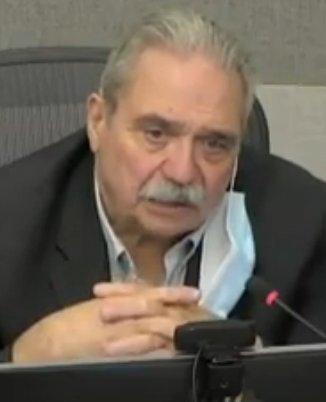
Councillor Bentivegna liked the idea of space being available for small groups that just want a place to be able to meet – right now they are meeting in coffee shops.
Counsellor Bentivegna: There’s things on the website that has Mums groups that meet just because they want to meet and talk about common interests; things to do with their one or two year old that can’t go to school. Can’t go to babysitters. They can sort of make their own little program.
Councillor Kearns who was Chairing the meeting, mentioned a “memo we got back in 2022 looked like it allocated about 42,000 square feet. I think it is for lobby area corridor space. These are supposed to be passive/interactive/community building spaces. And yet we’re being asked in this report, I believe, to comment on phase two, which is quite simply just 11,000 square feet.
“That entails the westerly part of the floor plan, which is the old shops, that are a kind of an icky area to be honest, and then maybe some additional passive use when we can have it which is the gymnasiums.. I didn’t know we gave up all three, but those represent 11,000 square feet as well. So if I don’t know what’s been determined for phase 1 how might I comment appropriately for what should be prioritized in phase 2 ?”
Beard: “The gyms are not part of the 11,000 square feet. Those were those are outside of the 11,000. The three shops are not included in the 11,000 either, so you have fairly significant spaces within the building right now. You’ve got the three shops which could be shops or not shops moving forward. You have the gyms that are not included in the open space.”
What was never made clear was: How much gym space has been allocated to Brock and how will whatever balance there might be get shared?
Beard continued: “There is this vast open space that you’re referring to as a communal courtyard area or lobby area, it is a significant footprint that we have the opportunity to shape and style up however we choose to – if we wanted to have a black box or if we wanted to have a gallery – there’s lots of space still available to have those discussions in addition to that lobby space.

Executive Director Alan Magi appears at times to be the lead on the refurbishment of the former Bateman High School. He has had problems in the past using the word asbestos.
Executive Director Alan Magi added: “There is considerable lobby space and that’s meant to be more of a social interacting space that is non exclusive. In general terms there could be an event or something like that, that takes up some of that space, but it’s meant to be sort of a mixing area between the different uses that are there between Brock students, library users, people that are coming to use the gym, maybe mom and dad jumping on the food theme. That space is intended to be a flexible area. That is gives us a lot of potential for programming in the future.”
Kearns: “Can we have a map at some point to identify the progress in terms of programming? This report is putting in scope the three shop areas which are on the westerly side of the of the property, and kind of icky and then the 11,000 of the potential 42,000 square feet of community space which is that open flex space. I don’t know if that means? Can use 500 of that for a community pantry? If we’re building in any sort of space that’s just going to be open space with programming. I just feel like I need to see two maps or two floor plans with where these potential pieces are. And I’m especially concerned about the gym space because we’ve encouraged the community to talk a lot about what gym facilities and gym activities they want to see without the benefit of technically having jurisdiction over deploying the use of that. I don’t know when and how much we’ve given to Brock. I don’t know if we’ve seen that – I don’t know that. So I feel like the expectations are high from the community and I’m not able to appropriately scope the first phase nor can I determine much about the second phase. I don’t have the the information I need – Why?”
Allan Magi – Yes, certainly. We can come back with plans that that show that you know the different space areas and as you get a better appreciation spatially where these are,
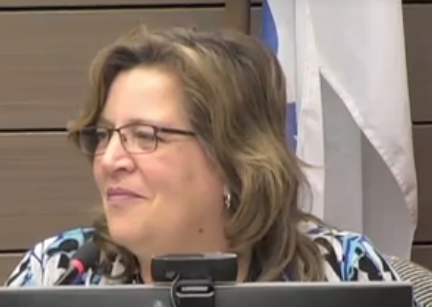
Ward 4 Councillor Shawna Stolte brings a cautious approach to what the programming at the RBCC will be – wants to be assured that special interests don’t take over the space.
Councillor Stolte wanted to be sure she fully understood what they were being asked to decide. “Are you asking us as to decide whether or not we want to proceed with no exclusive use. Is that what you need some clarity on? And do you need clarification on restricted space with the gyms? There are already some promises made to Brock based on that space.
“Are you looking for feedback from us as to what proportion you would like some direction on as far as 50% exclusive use and 50% open flexible space, or 70/30? What is it that you’re looking for at this point? Some direction on the proportion that council thinks the community is looking for?
Beard: “Great question. I’m not looking for a percentage but I would like your instincts on that. We don’t want it 100% exclusive or licensed out – we do want some guidance but we’re not looking for hard and fast numbers. What is your gut saying? No, we’d like this open flexible space idea that’s accommodating can meet, evolve with the community. I would like that kind of direction moving forward?
Recreation, Community and Culture Director Emily Cote added: “It is a bit of a shell game right now,as you know. I don’t have to explain to council you’re quite smart. The balance between exclusive use which is guaranteed revenue, and then the balance between ad hoc rentals, which is not as guaranteed. Finding the balance between the two in terms of the social enterprise with a certain percentage of guaranteed revenue which you get from an exclusive use.
Councillor Stolte: ” I would hate to see it exclusively designated for exclusive use. I think that would be a shame based on what we’ve heard from the community. There could be a little bit more exclusive use; if we were to use that flexible space and create some really interesting spaces – maybe do what some churches and our faith communities do – have family rooms that have couches and coffee tables that could be used for kids games nights, it could be for community groups that want to use it. It could be rented out by a family who wants to hold a baby shower or a family reunion. It would be a different kind of space than what we have at a Tansley Woods where it’s more of a just a big empty room with some chairs.”
Mayor Meed Ward: “I think where we are hung up is on this use of the words exclusive use. When I think about arts and culture exclusive use, I think about a blackbox studio that anybody could rent. It’s exclusively for people that want to record stuff. So exclusive use in that way. But anybody who wanted to go and record a Christmas album “and I won’t be doing that” could rent that space – it’s more than just an empty classroom with with chairs and a table it actually is a purpose built space.
“If what you are intending is a single theatre group would be given the arts and culture space to run their programs – I don’t want their programs. I’m a little less comfortable now with this set of categories because I thought you were asking us about what would you like the space to be used for. Anybody, should they choose, could participate in that activity. I love social services stuff. I love the skills trades. People coming in using those workshops, you know booking arts and theatre for whatever they want. So I need to understand what it is you’re asking of us right now because that will change my feedback as well.
Meed Ward added: “I’m not looking for more revenue here. We’ve got tons of capital and revenue already coming in from the other parts.”
Beard: “That’s exactly the questions we need from you. We have had theatre groups say they want the space for themselves. I will just use the black box as the example because it just keeps coming up. They want the black box for themselves. But if Council and other theatre groups coming forward saying – I don’t want exclusive use of the black box, but I want one available to use it for rehearsals or try something in a sound booth to do recordings.
“If if council or committee doesn’t want exclusive renters that’s one thing and that’s one question that we have here around these expressions of interest because that’s those are people saying to us, I want exclusive space dedicated to me. I will pay you a lease to run it so I can run my program versus we want to see a black box in this area and anybody but we want it to be available and open for anybody to use it. You don’t have to be affiliated with a certain organization to be able to permit that black box.”
Mayor Meed Ward: Okay, and so I’m leaning towards the latter part there. We would just rent it out on an allocation basis the way we do to various groups that use our current community centers. I feel a lot more egalitarian about that part.
Councillor Kearns asked: “At what point can we see if any commitments have been made thus far for the phase one versus the phase two, so that we can get a better and stronger sense of what we can fit where and the types of overlays?
“I wish we could have seen something and maybe this is available or not that you can give to counsel to say, here are 10 styles, can you rank what is most important to you? And that would be things like is it revenue generating?
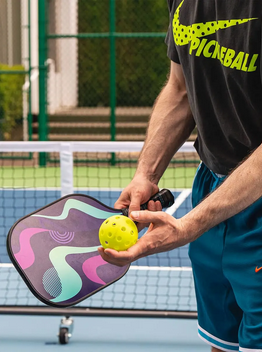
Pickleball players are expected to want significant use of gymnasium space
“Is it more play for more people or more access for more people? The pickleball folks, please do not freak out, you know, a whole gym for an hour with four people if it were only be for pickleball players versus a whole gym for two basketball teams playing each other. As an example. Is the guiding principle more play for more? Looking back at the financial matters, nowhere in here does it talk about how we’re looking to stream out cost cost offsets for operational costs and or potential capital. And if that’s something you’re asking Council to take into consideration I need to know more about that.
“If we had another overlay again on the particular areas that have already been committed and what that flex space could look like; how we’re actually planning to program with partners, so you know, the whole piece about the childcare I mean, that is a big conversation to even see in a report like this. That’s a whole strategy and financing plan and operational plan with the region. If that’s the case. I can give you one very easy hard no and that’s quite simply not to any commercial folks. Work with our business development people and we’ll find you something and no, you won’t get a cheaper rate just to work for profit. So I mean, if that’s something we can agree on – great.
“I’m not comfortable with this report. I think we’re getting portions of it. But from a holistic view, I think I need more to be comfortable to say. Yes. Let’s take the next steps. I’m not quite there yet. So I can’t refer it back to staff because we’re in committee. But I might think about doing something like that to get that next piece and bring those pieces closer together. So those are those are my thoughts at this point. Feeling very hesitant about it, but also extremely encouraged by how exciting the community is asking for new new opportunities to connect with each other. It just feels so huge – is a referral to staff back to bring us back a part two.
“What do you actually want us to prioritize a possibility or would that be helpful?
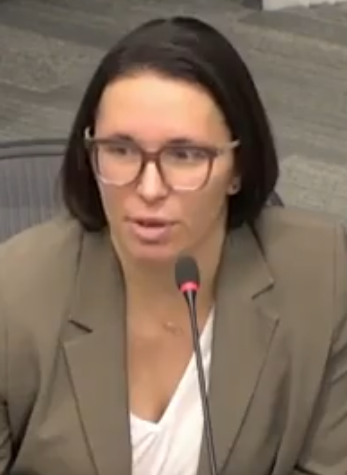
Emily Cote Director Recreation, Community and Culture.
Emily Cote: “We’ve employed the same process and allocating space and then and community engagement that we typically do when we create a new building. First we say who’s interested in exclusive use, then we kind of go okay, what kind of interest do we get? What do we get for the community and it is a bit of allocating of space also, while we’re figuring out that design, which is a huge component here. We can’t really build if we don’t know what the interest is. So it is a bit of a balance. We’re still in that balance stage. None of those things have been committed. They’re all for phase two. So when you know Councillor Kearns, you ask what does that 500 square feet get used for? Can it be for the food pantry? We don’t know yet. We’re just starting to have those conversations. The expression of interest was literally an expression of interest. There’s no contacts, no financials, none. No business plans were submitted from any of those folks. It was just like, hey, do you have an idea? It is very so conceptual. So, you know, in the interest of wanting to move forward I will ask Denise to kind of jump in – perhaps agreeing that no offices, no, you know, professional services. Let staff carry on with that and then perhaps report back in the same timeline as the outdoor engagement. We can be a little bit more concrete on what is starting to shape out. I just want to table that and then see if Denise wants to jump in.
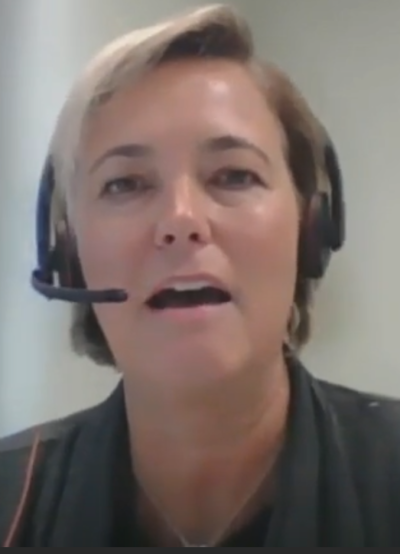
Senior Manager Community Planning, Parks, Recreation and Culture
Beard: The point of this report was what was community’s vision we’re just sharing with you what we heard from community and what we heard from potential service providers. And if there are non starters, if there’s a non starter opportunity that’s been presented here that you would like us not to pursue. That’s the start of the conversation if there’s something on the tables, we’re hearing commercial entered enterprise offices as a not, like an area we don’t want to explore we’ll make sure that when we talk to community about prioritization, because that’s our next step, that everyone understands. We’re asking council or committee right now. What don’t you want to see?
“And then we’ll take that off the table when we go out back out to community. That helps us to prioritize the space that’s remaining and asking the community – what is the most important. You need to help us figure out what the most important exercise looks like? We will be reporting that back – community is going to help us prioritize what we can and cannot fit within the building and then start to design it from there. This is all very high level conceptual at this stage. That’s that’s helpful feedback.
Sharman: “Thank you very much. For all of this: no offices, no businesses. No commandeering space for locked in usage forever. That said we’ll figure out the money in the budget and we’ll figure out fees and we’ll work all that out. I’m not stressed about that. At the moment. I’m thinking about how we build a community that is suitable for the human beings who will be coming here. And with 120,000 people, many of them will be immigrants and they’ll be from all over the world. So diversity in culture is going to be dramatically needed and we need to be on top of that and thinking about stimulating it.
“I think of the library doing more with respect to technology, you know, because books may be less of interest than perhaps the use of technology. And you know, we live in a world where the whole very, very world that we live in our intellectual capital and our knowledge and the way we communicate, you know, is changing.
“My point is we do need to have facilities in there for people to be able to do those kinds of things. We do need to have those facilities in there that people can cook if they wish to and have cooking lessons. So without taking over all the space but maybe we could have ideas of use by by by invent investing in some of the kinds of amenities that we need that to make it viable but yes, seniors and yes us. You know, we’ve got to have something flexible and usable and people can book it. By the way, I think he did a great job. This is the right way play. So well done.
Mayor Meed Ward: “I’m wondering about the recommendation which directs you to explore and excute exclusive use space to a limited number of categories and I’m not there so I’m just wondering if we should either take that language out entirely or and just receive and file this. The report is now a Receive and file – no action is being taken.”
Meed Ward continues: “I think it’s really important to distinguish between uses and users. And that’s where I get hung up on uses. I want to see a broad range and some of it can be very specific use.
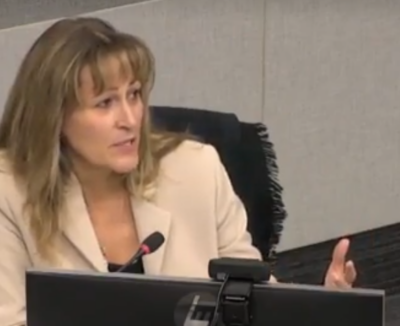
Mayor Marianne Meed Ward has been THE cheerleader for the project – says there is all kinds of money available.
“We don’t need to earn revenue from this. I see this as a public service. It’s a community center. It’s a public service, we’ve already subsidized it, not looking to get more revenue. One of the biggest requests I get, and I’m sure you do too, is for free meeting space. I am completely cool with that. Maybe we have one or two rooms. Those are the rooms for if you’re if you got a group and you want to meet and get together, knock yourself out do it.
“Same with some of our nonprofit sports organizations, our Hall of Fame group looking for for a home but but I don’t want dark space. That’s why you know if you do exclusive use and somebody only needs it two days a week it’s blocked and dark for the rest of the time. We don’t want that.
“Been really eye opening talking to you Emily recently and hearing just how much unused capacity we already have in facilities – the barrier is cost. People can’t or don’t want to you know pay when they’re just trying to get a group of friends together to talk about whatever they want to talk about. So anyway, I think you’ve heard us loud and clear – , there’s a lot of creative ways to use this space. And we shouldn’t limit ourselves to those that are able to sign a lease and give us revenue that that’s the least of our concerns.”
Councillor Stolte: “I’m glad that we’re distilling this down. It’s less about exclusive use. And it’s more about themed spaces that can be used, whether that be performance space, whether that be community kitchen space, it’s themed spaces that can be used by a variety of different organizations. The only one that I kind of still can’t wrap my head around is not giving a bit of exclusive use to, and maybe this is part of the workshops, is I was really keyed in when I was part of the community engagement sessions was about the Repair Cafe and the reuse Emporium because those really speak to our environmental goals that we’re trying to reach as far as having some exclusive use where people who have broken appliances rather than going to the dump, if they still want to use those appliances, they can come and have them repaired and take them home again. If they have no use for them. They can donate them they can be repaired and then put into this reuse Emporium for somebody else to use. So I do like the idea of a tiny bit of space that’s designated for certain other goals that we’re trying to reach like that.
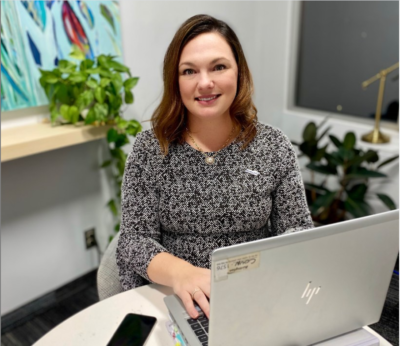
Councillor Lisa Kearns chaired the meeting that saw all kinds of ideas and viewpoints on the table. She got the meeting to the point where it would end as a Receive and File – with a lot more work to be done.
Councillor Kearns: “I think it’s really a huge demand that we’re trying to satisfy for trying to be everything to everybody. And I think that we can do that with very, very careful planning and proper sequencing, which is why it was first between phase one versus phase two. We heard a lot about this flex space and it’s sounding like we’re adding more empty space which is not what we want to do, to the Counsellor Stolte point – you know, can we find little cabinets that can be you know, for Repair. Can we find that living wall atrium? Absolutely? And then you have a drop in horticulture group that learns about it.
“Can we have the cooking areas one of the biggest challenges with the food banks is that once people get the food, they don’t know what to do with it. So if we want to actually tap into some of those systemic issues around community health and well being we need to teach people bring them along, as you said, break bread build culture. That’s how you do it. Seasonal cooking classes can help really maximize that.
“I don’t want to have a huge conversation around free, pure free, because I think you still have to add some value. I find that if people get something for free, they don’t value it. So very, very low accessible cost I think is as more the line that I want to see. Sometimes on Facebook marketplace, you can’t give something away for free you make it $2 And someone is banging down your door in 10 seconds. It doesn’t make any sense but that’s human nature. I like the ideas of the open gyms I really want to understand how much gym space we have. And if I were to be able to share my number one priorities it would be around you know, health and well being; mental health, physical health and community connections.
An indoor outdoor connection to a community garden, the Repair Cafe piece, super important. Arts and culture, whether it’s passive art and again this is why I wanted to see the footprints because we can have passive art that people can engage with and then we need active art and understand how that interplays with our own arts and culture here and the art gallery, and then around that, that last piece of you know, where do we go from here?
I think we need a lot more discussion. And I’m glad that it’s a receiving file. This is not our final blessing on this yet. I think we need to do a little bit more to scope it and get the guiding principles set in place and then encourage those operators to fall in within those guiding principles. So that’s it. Thank you,

Councillor Galbraith didn’t have much to add to the ideas that were being floated – he did however mention an Aldershot area program that could be repeated at the Robert Bateman Community Centre.
Counsellor Galbraith: “Lots of great ideas being thrown around. In Aldershot we have a community kitchen where chefs go and train once a day. I think it’s every Saturday you can go for a community breakfast for $2; knowing that you’re getting a chef and training cooking for you but it’s a community social space and they do lots of events that are that. I think something like that would be ideal just in hearing the conversation here.
“In a location like this, it brings the community together and they you know a lot of the food they make and training they donate to food banks and churches to hand out so something like that would be a great idea. I think we’re headed in the right direction and keep up the good work.”
Chair Kearns got them to voting to Receive and File – there is more work to be done – good progress was made – the public has been involved in getting to this point and Council has made it very clear what they want and don’t want.
It became clear that there is still a lot Council doesn’t know. The use of the property at the rear of the site; a decent set of floor plans with detail – council members were not sure as to what was going to be possible and where.
A lot of open space and a willingness to try new ideas to learn what works and what doesn’t work. It was a decent half days’ work.
Related news stories:
Part 2 – The pilot project plans.
















Fascinating to be taken on a deep dive of the inner workings of staff and council. Does Burlington need to reinvent the wheel? River Oaks in Oakville has a multi-purpose room that is expandable, ballet mirrors and barre on the wall, a closet to store tables, chairs, and gym matts, some cupboards and a sink, AV equipment is available. Flexible space that can be used for a variety of purposes and can be evolved over time as needs arise. Not rocket science, a great template for rooms at Bateman, might require council or staff to drive to Oakville to take a look. One has to wonder about the cost of staff time that’s going into Bateman to ponder what a community centre should look like.
Fascinating, like the inner workings of a broken clock.
I think that the City should be congratulated on what they are doing with the school. It shows good planning and is a very good investment. I like how we have all been involved in things like choosing a new name and in deciding what should be included in the centre. I don’t quite understand the fuss about paving over the track and the green space. Parking facilities will be needed – just logical. I wish we had known as much about the pier before it was built.